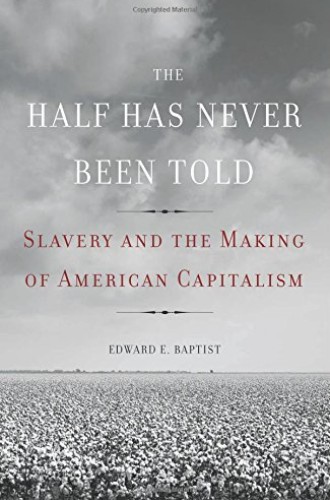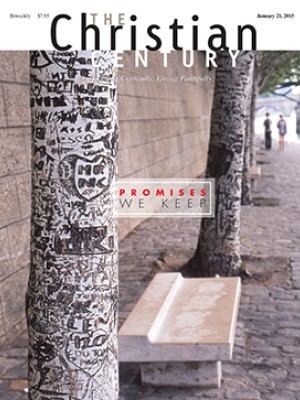The world slavery made
This book is the opposite of a page-turner. I don’t mean that the author fails. On the contrary, Edward Baptist has written one of the richest and most provocative accounts of American slavery I have ever read. He so powerfully captures the pain and tragedy of plantation slavery—of life in what he calls the “slave labor camps”—that I had to force myself to turn each page, fearing yet another punch in the gut. The book is painful to read.
The Half Has Never Been Told achieved considerable fame as soon as it was published because of an astonishingly stupid review in the Economist—one so bad that the magazine quickly retracted it. The reviewer’s basic point was that Baptist portrays all whites as villains (which he doesn’t) and all blacks as victims. Imagine that in a book about slavery! A social media storm ensued, led by parodies of the review on Twitter under the hashtag #economistbookreviews. The book quickly shot up in the Amazon book rankings, demonstrating yet again that there is no such thing as bad publicity.
Read our latest issue or browse back issues.
Baptist’s big book retells the story of southern history and American history from the ratification of the Constitution to the Civil War. The author brilliantly draws out the close relationship between plantation slavery in the newly opening territories and states of what was then called the Southwest (Kentucky, Alabama, Mississippi, Tennessee, and Texas) and the American capitalist explosion of the antebellum years.
Slavery in cotton country was efficiently and ruthlessly productive, Baptist documents: “The total gain in productivity per picker from 1800 to 1860 was almost 400 percent.” Planters figured out how to get more and more cotton bolls picked per hand per day, experimenting for years with the perverse incentives of a regime of torture. “We don’t usually see torture as a factor of production,” Baptist writes, but we should.
And the system worked. What that meant for the enslavers (a word he always prefers over slaveholders) was the possibility of getting fairly rich (and occasionally very rich) fairly quickly. The same animal spirits that drive all economic bubbles powered the one in the newly opening cotton regions, where those animal spirits had free rein to abuse, batter, rape, and break down the bodies of the enslaved.
Few readers other than professional historians know about the massive extent of the internal slave trade in the antebellum years—the buying and selling of slaves from the declining slave economies of the eastern seaboard (primarily in Virginia and North Carolina) to the booming economies of what became the Deep South black belt. From 1790 to 1860, upward of one million black people were taken, stolen, dragged in coffles, bounced in wagons, or placed on ships or steamboats, and carried from one region to another. By contrast, fewer than 400,000 Africans arrived in North America via the transatlantic Middle Passage trade from 1619 to 1808.
The internal slave trade made the antebellum South. Enslaved people did the work that powered approximately half the American economy, Baptist argues. He counts not just the products they grew and picked, but all the ancillary second- and third-order economic support systems for the plantations, such as the production in northern factories of axes that were perfectly made to deforest southern lands in preparation for cotton planting. The multiplier effect of slavery was astonishingly effective in producing a boom.
In the most important sections of this work—the best treatment of the subject I have ever seen—Baptist discusses precisely how the slave regime powered the early financial industry in the United States, and the banking system in particular. In one brilliant chapter, he explains in layperson’s terms that borrowers secured their mortgages using slaves as collateral. This spread risk and helped to finance the astonishing boom in the Southwest from the early 19th century until the days of reckoning after the Panic of 1837.
Like the financial services industry in the 1990s and 2000s, the planters and bankers of the 1820s and 1830s had learned to privatize gain and socialize risk. They got state governments to guarantee bonds they took out using slave collateral. If their ventures failed, the state would pick up the tab, but if they succeeded, they would get rich.
Baptist draws on his considerable skills of literary re-creation to make the reader feel at least something of what it was like to be enslaved. He employs a huge array of firsthand accounts and creates “you are there” scenarios. Some reviewers have complained of Baptist’s fictionalizations, but I see little reason for concern. And I see even less reason to downgrade the book (as some have) for repeated use of the “f” word on a couple of pages. The author is offering a clever etymological exploration of the word and its relevance for this case.
Baptist writes in just about every genre of prose at some point in the book, from the most straightforward and conventional to the most literary and experimental. Readers will respond to particular passages according to their own taste. To me, most of it worked, some of it very impressively.
Religion on the slave frontier receives a fairly short but very good treatment in the middle of the book. “The acceleration of slavery’s expansion,” Baptist writes, “was hell—separation from all that gave life in the world meaning.”
It did not help that after Nat Turner’s rebellion in 1831, white ministers “eagerly promised that they would henceforth work harder than ever to make Christianity into a tool that would help enslavers govern their society.” Whites condemned male slaves for failing to resist heroically, and thus for being unmanly. Baptist counters with a memorable passage about the everyday nonheroic (that is, nonsuicidal) virtues practiced by slaves—moments of community, kindness, and grace as they walked in a world that was hell without fire.
This is not a comprehensive history of American slavery. It is not about slaves in Virginia’s tobacco fields or about Richmond’s industries; about domestic servants or artisans in southern cities; about black cowboys in Texas; or about slave economies and lives outside the boom belt created by southwestern enslavers and their financiers. In the Southwest, though, American slavery could be seen in its raw fullness.
“Slavery permitted unchecked dominance and promised unlimited fulfillment of unrestrained desire,” Baptist writes, and “one cannot understand it without studying both careful calculation and passionate craving.” This book addresses both with an effectiveness achieved by few other authors.






